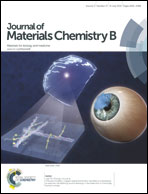RIR-MAPLE deposition of multifunctional films combining biocidal and fouling release properties†
Abstract
Multifunctional films with both antimicrobial activity and fouling-release ability based on a biocidal quaternary ammonium salt (QAS) and thermo-responsive poly(N-isopropylacrylamide) (PNIPAAm) were deposited on substrates using resonant infrared, matrix-assisted pulsed laser evaporation (RIR-MAPLE). The surface properties of these films were characterized by X-ray photoelectron spectroscopy (XPS), Fourier transform infrared (FTIR) spectroscopy, atomic force microscopy (AFM), and water contact angle measurements. The biocidal and release properties of the films were tested against Escherichia coli K12 and Staphylococcus epidermidis. At 37 °C, the deposited film facilitated bacterial attachment and killed a majority of attached bacteria. Decrease of the temperature to 25 °C promoted the hydration and at least partial dissolution of PNIPAAm, leading to bacterial detachment from the film. To enhance the retention of PNIPAAm on the substrate, a small amount of (3-aminopropyl)triethoxysilane (APTES) was incorporated as a stabilizer, resulting in a ternary film with biocidal activity and bacterial-release ability after several attach-kill-release cycles. The simplicity and universality of RIR-MAPLE to form films on a wide range of substrata make it a promising technique to deposit multifunctional films to actively mitigate bacterial biofouling.


 Please wait while we load your content...
Please wait while we load your content...